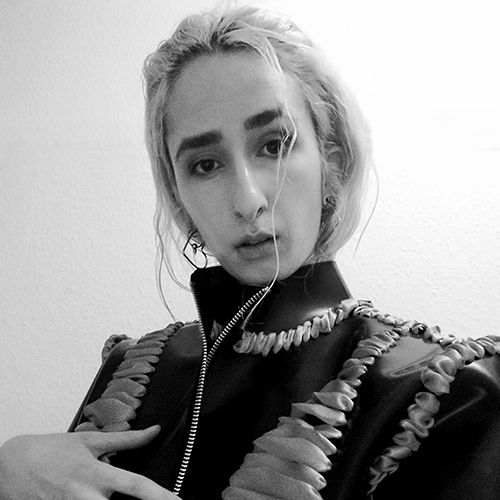
Teodora Mitrovska
Designer
Label - T*MITROVSKA
I produce only one collection per year
T*MITROVSKA is a highly conceptual London-based brand playing with unconventional materials, shapes and gender roles and is funded by a young and extremely talented designer Teodora Mitrovska. She was recently BIG SEE Fashion Design 2021 winner for North Macedonia. In an interview with Fibre2Fashion, the designer explains about her inspiration behind her eclectic collection and shares her thoughts on gender fluid and slow fashion.
Fibre2Fashion: Where are you based and how would you describe style and fashion in your country?
Teodora Mitrovska:
I am based in London, UK, which makes it quite hard to describe a particular style or fashion. Being one of the world’s fashion capitals, I think London has such an eclectic and diverse fashion scene, I wouldn’t be able to pinpoint one style in particular and I think that’s what makes it so amazing and exciting for designers like myself.
F2F: What bought your interest in fashion and what was the motive behind starting your own label?
TM:
I can’t really remember a particular moment that got me interested in fashion. As cliché as this will sound, I really have always been into fashion. I remember starting to do fashion sketches even in kindergarten, when I was around 4-5 years old, and I haven’t stopped since. I guess it came naturally, rather than an interest that emerged at a certain point. Similar to this, there was never a point where I decided that I will start a brand. When I graduated from BA Fashion Design at Middlesex University in 2018, I started getting editorial requests from magazines and I even showed my graduate collection at a couple of European fashion weeks, so I was asked to provide a name to credit the work. I guess it made most sense to start presenting myself and my work as a brand. Only later I started slowly developing and becoming an actual brand. It was a process.
F2F: How would you describe the aesthetic of your brand?
TM:
It’s all about unconventional materials, unconventional shapes and unconventional gender roles. There is always a reference to uniforms and fetish-wear, but ultimately, I am trying to create imaginary worlds with my work. So, with every new collection it’s the story that drives the design process, rather than a brand aesthetic I am trying to adhere to.
F2F: Where do you find your inspiration for your gender-bending and eclectic collections like ‘20.18’ and ‘We are not Machines’? What did you want to convey?
TM:
F2F: How is your brand’s approach towards sustainable and slow fashion?
TM:
I am a strong advocate for slow fashion! I produce only one collection per year and am really focusing on building core timeless items for my ready-to-wear pieces. I think quality is always better than quantity and as small independent brands we have the freedom to choose how many collections we are going to produce and how many styles per collection we will have.
F2F: How has gender fluid fashion evolved over the years?
TM:
I think what we can talk about is how it’s become more transparent and acceptable. Gender-fluid fashion has existed for a long time, and so have people that have been challenging gender norms. The thing that has changed is that we, as a society, have become more educated and are open to accepting it. This is important and fashion has had a big part in it. I think that everyone should feel free and safe to present and dress how they want, so breaking the gender stereotypes in any sense, including clothing, is very important.
F2F: What does your brand offer to Gen-Z and millennials? What makes your label stand out?
TM:
I am not sure. I don’t think I am trying to offer anything to a particular generation or a cultural group. I guess my approach to fashion is slightly different to a typical clothing brand. I am never interested in following trends or offering a lifestyle to a certain group of people, like I think most brands do. I see fashion as more of an art form that allows you to communicate your world / story / vision / ideas in a timeless manner.
F2F: What does your brand offer to Gen-Z and millennials? What makes your label stand out?
TM:
I am not sure. I don’t think I am trying to offer anything to a particular generation or a cultural group. I guess my approach to fashion is slightly different to a typical clothing brand. I am never interested in following trends or offering a lifestyle to a certain group of people, like I think most brands do. I see fashion as more of an art form that allows you to communicate your world / story / vision / ideas in a timeless manner.
F2F: Where do you see your label in the next 5 years?
TM:
Probably in more physical stores and more-so galleries than fashion shows. I am also hoping it will be a self-sustaining business which will allow me to fully dedicate myself to it.

Gabi Seligsohn
Arun Sirdeshmukh
Aseem Prakash
Abhay Gupta
Pradip Mehta
Rahul Mehta
Fanny Vermandel
Rahul Mehta
Anurag Batra
Bill D’Arienzo


20230103183907.png)







_8.JPG)


